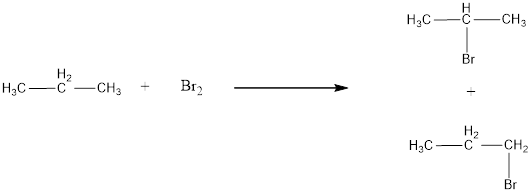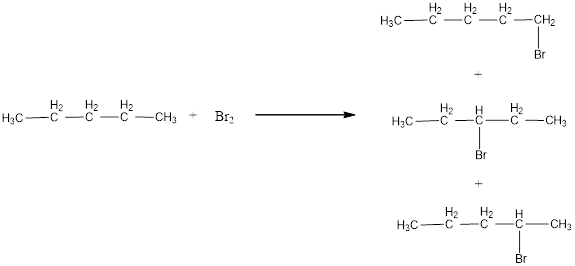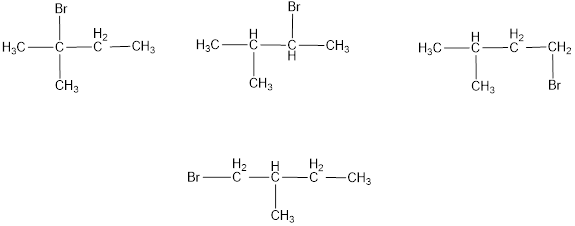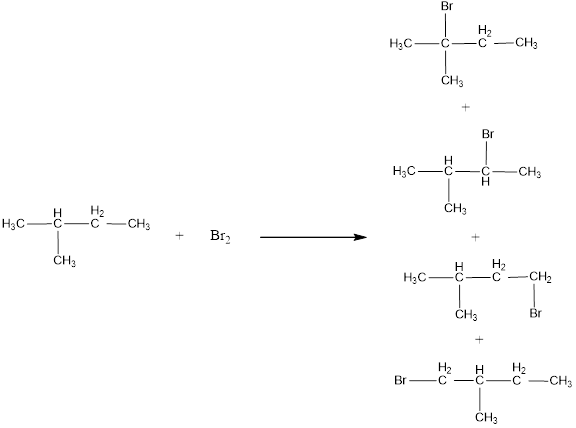
Concept explainers
(a)
Interpretation:
Structural formula for all the possible monobrominated products obtained from halogenation of propane has to be written.
Concept Introduction:
Alkanes are not completely inert. Two important reactions that alkanes undergo are combustion and halogenation.
Combustion reaction is the one where reaction occurs between substance and oxygen which proceeds with evolution of light and heat. Due to the heat produced when alkanes are made to undergo combustion with oxygen, it is used as fuel.
Halogenation is a
Halogenation reaction of alkane is an example of substitution reaction. This is a reaction where a part of reacting molecule replaces an atom or group of atoms in hydrocarbon or hydrocarbon derivative.
Cycloalkanes are also similar to those of alkanes. Cycloalkanes also undergo combustion and halogenation reaction.
(a)
Answer to Problem 1.134EP
The monobrominated products of propane are,

Explanation of Solution
Halogenation is a chemical reaction between a substance and halogen. The product of halogenation reaction is that one or more halogens are incorporated into molecules of the substance. Halogenation of hydrocarbon gives hydrocarbon derivatives as product where halogen atoms are substituted instead of hydrogen atoms.
Halogenation reaction of alkane is an example of substitution reaction. This is a reaction where a part of reacting molecule replaces an atom or group of atoms in hydrocarbon or hydrocarbon derivative.
General reaction for halogenation of alkane can be given as shown below,
The halogenation reaction takes place giving a mixture of products where the hydrogen atoms present in the alkane are substituted randomly.
Given alkane is propane. Two kinds of hydrogen is present in propane. Therefore, bromination of propane will lead to two monobrominated product as shown below,

The structural formula for monobrominated product of propane was drawn.
(b)
Interpretation:
Structural formula for all the possible monobrominated products obtained from halogenation of pentane has to be written.
Concept Introduction:
Alkanes are linear chain saturated hydrocarbons. The reactivity of alkanes are very less. They can be heated for a very long time in strong acids and bases without any reaction. Even strong reducing and strong oxidizing agents have less effect on alkanes.
Alkanes are not completely inert. Two important reactions that alkanes undergo are combustion and halogenation.
Combustion reaction is the one where reaction occurs between substance and oxygen which proceeds with evolution of light and heat. Due to the heat produced when alkanes are made to undergo combustion with oxygen, it is used as fuel.
Halogenation is a chemical reaction between a substance and halogen. The product of halogenation reaction is that one or more halogens are incorporated into molecules of the substance. Halogenation of hydrocarbon gives hydrocarbon derivatives as product where halogen atoms are substituted instead of hydrogen atoms.
Halogenation reaction of alkane is an example of substitution reaction. This is a reaction where a part of reacting molecule replaces an atom or group of atoms in hydrocarbon or hydrocarbon derivative.
Cycloalkanes are also similar to those of alkanes. Cycloalkanes also undergo combustion and halogenation reaction.
(b)
Answer to Problem 1.134EP
The monobrominated products of pentane are,

Explanation of Solution
Halogenation is a chemical reaction between a substance and halogen. The product of halogenation reaction is that one or more halogens are incorporated into molecules of the substance. Halogenation of hydrocarbon gives hydrocarbon derivatives as product where halogen atoms are substituted instead of hydrogen atoms.
Halogenation reaction of alkane is an example of substitution reaction. This is a reaction where a part of reacting molecule replaces an atom or group of atoms in hydrocarbon or hydrocarbon derivative.
General reaction for halogenation of alkane can be given as shown below,
The halogenation reaction takes place giving a mixture of products where the hydrogen atoms present in the alkane are substituted randomly.
Given alkane is pentane. Three kinds of hydrogen atoms are present in pentane. Therefore, bromination of pentane will lead to three monobrominated product as shown below,

The structural formula for monobrominated products of pentane was drawn.
(c)
Interpretation:
Structural formula for all the possible monobrominated products obtained from halogenation of 2-methylbutane has to be written.
Concept Introduction:
Alkanes are linear chain saturated hydrocarbons. The reactivity of alkanes are very less. They can be heated for a very long time in strong acids and bases without any reaction. Even strong reducing and strong oxidizing agents have less effect on alkanes.
Alkanes are not completely inert. Two important reactions that alkanes undergo are combustion and halogenation.
Combustion reaction is the one where reaction occurs between substance and oxygen which proceeds with evolution of light and heat. Due to the heat produced when alkanes are made to undergo combustion with oxygen, it is used as fuel.
Halogenation is a chemical reaction between a substance and halogen. The product of halogenation reaction is that one or more halogens are incorporated into molecules of the substance. Halogenation of hydrocarbon gives hydrocarbon derivatives as product where halogen atoms are substituted instead of hydrogen atoms.
Halogenation reaction of alkane is an example of substitution reaction. This is a reaction where a part of reacting molecule replaces an atom or group of atoms in hydrocarbon or hydrocarbon derivative.
Cycloalkanes are also similar to those of alkanes. Cycloalkanes also undergo combustion and halogenation reaction.
(c)
Answer to Problem 1.134EP
The monobrominated products of 2-methylbutane are,

Explanation of Solution
Halogenation is a chemical reaction between a substance and halogen. The product of halogenation reaction is that one or more halogens are incorporated into molecules of the substance. Halogenation of hydrocarbon gives hydrocarbon derivatives as product where halogen atoms are substituted instead of hydrogen atoms.
Halogenation reaction of alkane is an example of substitution reaction. This is a reaction where a part of reacting molecule replaces an atom or group of atoms in hydrocarbon or hydrocarbon derivative.
General reaction for halogenation of alkane can be given as shown below,
The halogenation reaction takes place giving a mixture of products where the hydrogen atoms present in the alkane are substituted randomly.
Given alkane is 2-methylbutane. Four kinds of hydrogen atoms are present in 2-methylbutane. Therefore, bromination of 2-methylbutane will lead to four monobrominated product as shown below,

The structural formula for monobrominated products of 2-methylbutane was drawn.
(d)
Interpretation:
Structural formula for all the possible monobrominated products obtained from halogenation of cyclohexane has to be written.
Concept Introduction:
Alkanes are linear chain saturated hydrocarbons. The reactivity of alkanes are very less. They can be heated for a very long time in strong acids and bases without any reaction. Even strong reducing and strong oxidizing agents have less effect on alkanes.
Alkanes are not completely inert. Two important reactions that alkanes undergo are combustion and halogenation.
Combustion reaction is the one where reaction occurs between substance and oxygen which proceeds with evolution of light and heat. Due to the heat produced when alkanes are made to undergo combustion with oxygen, it is used as fuel.
Halogenation is a chemical reaction between a substance and halogen. The product of halogenation reaction is that one or more halogens are incorporated into molecules of the substance. Halogenation of hydrocarbon gives hydrocarbon derivatives as product where halogen atoms are substituted instead of hydrogen atoms.
Halogenation reaction of alkane is an example of substitution reaction. This is a reaction where a part of reacting molecule replaces an atom or group of atoms in hydrocarbon or hydrocarbon derivative.
Cycloalkanes are also similar to those of alkanes. Cycloalkanes also undergo combustion and halogenation reaction.
(d)
Answer to Problem 1.134EP
The monobrominated products of cyclohexane is,

Explanation of Solution
Halogenation is a chemical reaction between a substance and halogen. The product of halogenation reaction is that one or more halogens are incorporated into molecules of the substance. Halogenation of hydrocarbon gives hydrocarbon derivatives as product where halogen atoms are substituted instead of hydrogen atoms.
Halogenation reaction of alkane is an example of substitution reaction. This is a reaction where a part of reacting molecule replaces an atom or group of atoms in hydrocarbon or hydrocarbon derivative.
General reaction for halogenation of alkane can be given as shown below,
The halogenation reaction takes place giving a mixture of products where the hydrogen atoms present in the alkane are substituted randomly.
Given cycloalkane is cyclohexane. Only one kind of hydrogen is present in cyclohexane. Therefore, bromination of cyclohexane will lead to the same monobrominated product as shown below,

The structural formula for monobrominated product of cyclohexane was drawn.
Want to see more full solutions like this?
Chapter 1 Solutions
Organic And Biological Chemistry
- What are the major products of the following reaction? Please provide a detailed explanation and a drawing to show how the reaction proceeds.arrow_forwardWhat are the major products of the following enolate alkylation reaction? Please include a detailed explanation as well as a drawing as to how the reaction proceeds.arrow_forwardA block of zinc has an initial temperature of 94.2 degrees celcius and is immererd in 105 g of water at 21.90 degrees celcius. At thermal equilibrium, the final temperature is 25.20 degrees celcius. What is the mass of the zinc block? Cs(Zn) = 0.390 J/gxdegrees celcius Cs(H2O) = 4.18 J/gx degrees celcusarrow_forward
- Potential Energy (kJ) 1. Consider these three reactions as the elementary steps in the mechanism for a chemical reaction. AH = -950 kJ AH = 575 kJ (i) Cl₂ (g) + Pt (s) 2C1 (g) + Pt (s) Ea = 1550 kJ (ii) Cl (g)+ CO (g) + Pt (s) → CICO (g) + Pt (s) (iii) Cl (g) + CICO (g) → Cl₂CO (g) Ea = 2240 kJ Ea = 2350 kJ AH = -825 kJ 2600 2400 2200 2000 1800 1600 1400 1200 1000 a. Draw the potential energy diagram for the reaction. Label the data points for clarity. The potential energy of the reactants is 600 kJ 800 600 400 200 0 -200- -400 -600- -800- Reaction Progressarrow_forwardCan u help me figure out the reaction mechanisms for these, idk where to even startarrow_forwardHi, I need your help with the drawing, please. I have attached the question along with my lab instructions. Please use the reaction from the lab only, as we are not allowed to use outside sources. Thank you!arrow_forward
- Hi, I need your help i dont know which one to draw please. I’ve attached the question along with my lab instructions. Please use the reaction from the lab only, as we are not allowed to use outside sources. Thank you!arrow_forward5. Write the formation reaction of the following complex compounds from the following reactants: 6. AgNO₃ + K₂CrO₂ + NH₄OH → 7. HgNO₃ + excess KI → 8. Al(NO₃)₃ + excess NaOH →arrow_forwardIndicate whether the product formed in the reaction exhibits tautomerism. If so, draw the structure of the tautomers. CO₂C2H5 + CH3-NH-NH,arrow_forward
- Draw the major product of this reaction N-(cyclohex-1-en-1-yl)-1-(pyrrolidino) reacts with CH2=CHCHO, heat, H3O+arrow_forwardDraw the starting material that would be needed to make this product through an intramolecular Dieckmann reactionarrow_forwardDraw the major product of this reaction. Nitropropane reacts + pent-3-en-2-one reacts with NaOCH2CH3, CH3CHOHarrow_forward
 Organic And Biological ChemistryChemistryISBN:9781305081079Author:STOKER, H. Stephen (howard Stephen)Publisher:Cengage Learning,
Organic And Biological ChemistryChemistryISBN:9781305081079Author:STOKER, H. Stephen (howard Stephen)Publisher:Cengage Learning, General, Organic, and Biological ChemistryChemistryISBN:9781285853918Author:H. Stephen StokerPublisher:Cengage Learning
General, Organic, and Biological ChemistryChemistryISBN:9781285853918Author:H. Stephen StokerPublisher:Cengage Learning World of Chemistry, 3rd editionChemistryISBN:9781133109655Author:Steven S. Zumdahl, Susan L. Zumdahl, Donald J. DeCostePublisher:Brooks / Cole / Cengage Learning
World of Chemistry, 3rd editionChemistryISBN:9781133109655Author:Steven S. Zumdahl, Susan L. Zumdahl, Donald J. DeCostePublisher:Brooks / Cole / Cengage Learning- Chemistry: Matter and ChangeChemistryISBN:9780078746376Author:Dinah Zike, Laurel Dingrando, Nicholas Hainen, Cheryl WistromPublisher:Glencoe/McGraw-Hill School Pub Co
 Chemistry: Principles and PracticeChemistryISBN:9780534420123Author:Daniel L. Reger, Scott R. Goode, David W. Ball, Edward MercerPublisher:Cengage Learning
Chemistry: Principles and PracticeChemistryISBN:9780534420123Author:Daniel L. Reger, Scott R. Goode, David W. Ball, Edward MercerPublisher:Cengage Learning Chemistry: The Molecular ScienceChemistryISBN:9781285199047Author:John W. Moore, Conrad L. StanitskiPublisher:Cengage Learning
Chemistry: The Molecular ScienceChemistryISBN:9781285199047Author:John W. Moore, Conrad L. StanitskiPublisher:Cengage Learning





